ISRAEL'S MAGNA CARTA IS 100 YEARS OLD
by Julian Zuckerbrot, April 21, 2020
How the road to a Jewish state came to be built through an Italian resort town.
San Remo is a picturesque spot on the Italian Riviera with a casino, a beach, and plenty of cafes and restaurants: the unlikeliest location for one of the most important events in the history of the modern Middle East. Yet it was in this pleasant resort town that, almost precisely a century ago, the leaders of the most powerful countries in the world — the victors of the First World War — re-drew the maps of the Middle East. They took what, for 400 years, had been the possessions of the Ottoman Empire and, in their place, laid the groundwork for the emergence of Iraq, Jordan, Syria and Lebanon — and of Israel.
In the political and legal struggle for a Jewish homeland, what emerged from that Italian town during the month of April 1920 — later endorsed by additional treaties and ratified by the world community — was the greatest development to take place between the first Zionist Congress in 1897 and the declaration of the State of Israel in 1948. The Balfour Declaration of 1917 was significant because it expressed Great Britain's sympathy, support, and its desire to assist in the re-establishment of a Jewish homeland in Palestine; when the Declaration was included in the resolution that came out of the San Remo Conference, backed by the world community, it gained legal and political force. The San Remo Resolution created legal title to a specific territory that would be a state for the Jews. Nothing that has taken place in the last hundred years has replaced it or lessened its effect.[1]
The San Remo Resolution is "Israel's Magna Carta," in the words of Lord Curzon, the British foreign secretary who championed it at the conference. "This is the most momentous political event in the whole history of our movement," Chaim Weizmann, who led the Zionist Organization delegation at San Remo, said not long afterwards. And, added the man who went on to become the first President of Israel "perhaps...in the whole history of our people since the Exile."
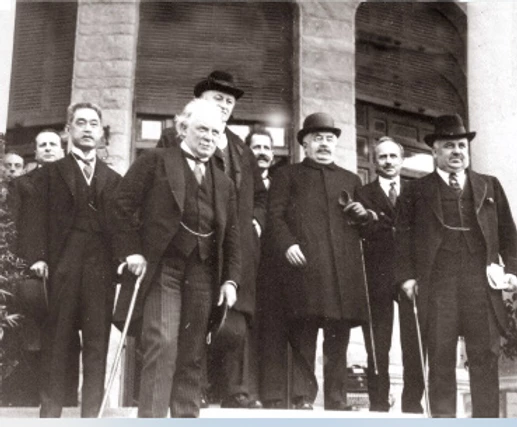
The San Remo Resolution evolved into the League of Nations Mandate for Palestine, which was ultimately incorporated in the United Nations Charter, and so carries more weight in international law than anything to come out of the UN. It is far more significant, for example, than the much better-known UN Resolution 181 of 1947, which called for the splitting of Palestine into two states. As with all General Assembly resolutions, that one could only be a recommendation, and it was in any case trampled into the dust by the armies that attacked the new nation of Israel.
You wouldn't likely find out about any of that if you were planning a holiday at San Remo, since tourists aren't told about the historical significance of the place. Without being aware of it, you might book your stay at the villa where the conference was held.[2] Even if you decided to read up on what happened there a century ago, you might not realize the importance accorded to the Conference at the time,[3] at least by those with a stake in the region.
The years leading up to San Remo had been ones of great and sudden change in the Middle East. For some time the ancient Ottoman Empire had been teetering, but its collapse was precipitated by the decision to join the Central Powers — the doomed German and Austro-Hungarian Empires — in opposition to the Triple Entente — the Allies — in what was to become known as the First World War.
To the victors, in all wars throughout history, go the spoils; the territories of the losers of this war would be divided up by the winners. But it was a time when colonialism was beginning to fall out of favour — whether the world's empires were aware of it or not — and a time of rising feelings of nationalism. That would affect how the victors would draw the maps of the post-War world; maps of Europe, the Middle East, and places as far from the battlefield trenches as Africa and East Asia.
There had been years of to-ing and fro-ing over who would get what — promises made, secret treaties negotiated — but it was at the San Remo Conference where those flimsy and sometimes contradictory words would, for better and for worse, become facts. The San Remo Resolutions outlined the borders and erected the legal underpinnings for new, independent states to arise out of the ashes of the Ottoman Empire.
San Remo did not exist in isolation, but was rather part of a process. A year earlier there had been the Peace Conference in Paris, where the victors in the Great War established the League of Nations — the predecessor of the United Nations — and dealt with the fates of all the defeated empires. Delegations of supplicants attended in order to put forward their arguments for a share of the post-War order.
Among those delegations was the Zionist Organization, their case for a Jewish national home supported by the widely publicized but aspirational Balfour Declaration. Not only was the Declaration not a binding legal document, it neglected to indicate what was meant by the term "national home," or what that the borders of that home would be. At Paris, the Zionist Organization's delegation asked for an "autonomous Commonwealth" that would include territory on both sides of the Jordan River, the Golan Heights, and what is today southern Lebanon; that would assure them a country with sufficient arable land and fresh water.
Another delegation was the Arabs, represented by the Hashemites, hereditary rulers of the Muslim holy cities, who had supported Britain during the War. Their delegation at Paris was headed by the Emir Feisal, one of the sons of Hussein, the Sharif of Mecca. He was assisted by T.E. Lawrence — Lawrence of Arabia, Feisal's former comrade in arms from the Arab revolt — who was part of the British delegation.
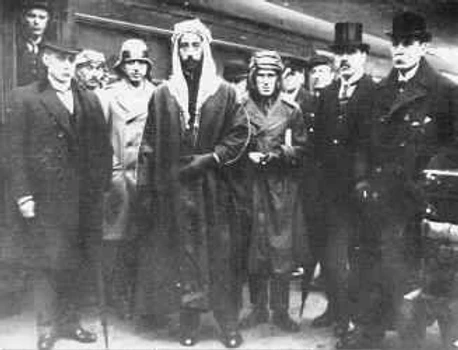
This photo: At the Peace Conference in Paris, 22nd January 1919. The Emir Faisal (1885 - 1933) king of the Helaz, who became King Faisal I of Iraq (centre) with (left to right) General Nuri Es-Sa'id (1888 - 1958); Anglo-Irish soldier and Arabist Thomas Edward Shaw (Lawrence of Arabia, 1888 - 1935); and Captain Pisani of the French Mission. (Photo by Hulton Archive/Getty Images)
At Paris — despite what we might assume, considering what has since transpired in the region — the Zionists and the Arabs supported each other's claims. They had even signed an agreement, albeit a secret one, in which both groups promised "the closest possible collaboration." In Feisal's appearance before the conference on February 6, 1919, he both demanded Arab independence and stated that Palestine should be set aside for the "Zionist Jews."
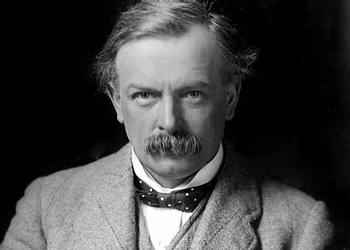
|
Feisal's support for a Jewish state, however, was conditional on his own demands being met. After all, the insurrection against the Turks that the Hashemites had conducted on behalf of the Allies came at a price (aside from large amounts of gold): Britain's support for Arab independence after the War. The British wanted to deliver on their promise to the Arabs — and to the Zionists — but they had also committed themselves to France having a stake in the region. ("The friendship of France is worth ten Syrias," Great Britain's David Lloyd George has been quoted as saying to France's Georges Clemenceau.)And the prime concern of the British was in securing their own interests, particularly protecting the Suez Canal and having access to oil. |
Some principles were established at the Paris portion of what we might today call a "peace process," which lasted from January to June of 1919, but the many hard decisions were left for later. A resolution was passed stating that "Armenia, Syria, Mesopotamia and Kurdistan, Palestine and Arabia must be completely severed from the Turkish Empire." (The European drafters of the resolution had turned to their own tradition in employing the terms Mesopotamia — today's Iraq — and Palestine, which were not official names under the 400 years of Turkish rule.)
As for the dilemma of whether those places would be colonies or independent nations, a solution was proposed at Paris by Jan Smuts, the South African representative, under which conquered territories would be placed under a series of League of Nations "mandates." They would eventually become independent states, but only after a period of Allied "tutelage," under the supervision of the League's Council. The compromise was formally adopted by the Conference as Article Twenty-Two of the League of Nations Covenant.
So it was at Paris that the victors in what they called the "war to end all wars" sketched out the broad strokes of a world they hoped would be a more fair and peaceful one. Negotiations to fill in the details went on among the Great Powers, the "Supreme Council," even after their representatives had left the city. The impossible task of dividing up the Middle East to the satisfaction of all concerned would be concluded at San Remo the following April. The months between the two events were by no means uneventful.
At the time, most of the Middle East was still occupied by the British, whose forces — including soldiers from its Empire and a sizable Jewish battalion — had, without much help from the other Allies, driven out the Turks. The military administration left in charge consisted of lower-level functionaries drawn from the army and the Anglo-Egyptian civil service.
Unlike cabinet ministers in London, most of whom supported the Zionist cause, Britain's representatives in Palestine tended to sympathize with the more "exotic" Arabs. There was a great deal of friction between them and the local Zionist leaders who — unlike the diplomatic and worldly Chaim Weizmann — tended to be plain-speaking, no-nonsense types, intent on building their homeland, with very little patience for anything that stood in their way. Communication between the military administration and Zionist leaders in Palestine was practically non-existent when negotiations began in Paris.
The local administration's attitudes were also shaped by the fact that the Muslims were by far the largest group in Palestine at that time. The Muslim population had grown from some 260,000 in 1882 to more than double that figure by 1919, largely because of immigrants from surrounding countries who were drawn by the prosperity that Jewish settlement had brought. Fear of offending the "Arab street" was as much a consideration then as now. The military administration in Palestine wanted to avoid having to defend the Jews — and themselves — from Arabs angered by London's pro-Zionist policies.
During the same period, a sense of nationalism was beginning to take hold among the younger Arabs in the region, on top of the loyalty that their parents had always maintained towards their family and clan. It was a sense of Syrian identity that emerged out of some combination of growing prosperity, increasing education, unhappiness with "infidels" being in charge, and a resentment of the Zionists and their modern, alien ways. It was not a Palestinian Arab identity — something that did not appear until decades later — but rather the opposite: a rejection of the foreign idea of a place called Palestine that was separate from Syria.
So, concerned with a possible increase in Arab violence, the local authorities turned a blind eye when the anti-Zionists began staging public protests. The government's strategy may have been to allow the protests to go on as an escape valve for Arab unrest, but under the Turks such lack of action by the authorities was to be understood as official approval. In January and again in March, Arab raiders launched attacks in Galilee, killing several people, including the war hero Joseph Trumpeldor. Just before the start of the San Remo Conference, crowds celebrating a Muslim feast in Jerusalem, egged on by agitators, some from outside Palestine began three days of rioting that left several dead and hundreds wounded. A message had been sent. The British chose to mete out the lightest of punishments on the perpetrators.
Feisal, meanwhile, was in Damascus, where, after the Ottomans were driven out in 1918, he had established an "emirate." The British had given him a relatively free hand to govern, but Feisal knew they were about to turn control of Syria — which included Lebanon — over to France. Prime Minister Clemenceau was offering him only a limited degree of independence under a French mandate, and only in the interior of the country. Feisal reluctantly accepted the offer, although he was aware he would have a hard time convincing some of his more extreme followers to accept it.
Unable to rally sufficient support for Clemenceau's terms among the moderates, Feisal bowed to the extremists. In March he convened the "General Syrian Congress," which not only repudiated the agreement with France but declared an independent Syria, including Palestine, with Feisal as king.
That put him on a collision course with the French. The British were incensed because, while Syria would no longer be their concern, Feisal was claiming to speak on behalf of all the Arabs. It also marked the end of Feisal's collaboration with the Zionists. He never met publicly with them after the middle of 1919 and he requested that they not refer to him in their statements. Out of consideration to Feisal, the Jews kept the existence of their agreement with him secret until after his death. The facts came out only when a journalist revealed them in 1936.
Western witnesses in Syria describe conditions during this period as chaotic.People were fearful, reluctant to carry on daily activities. Christians in Lebanon took the opportunity to declare Lebanese independence. With matters getting out of hand in Palestine and Syria, negotiations to finalize the new arrangements for the region were set for the Villa Devachan in San Remo on the 19th of April, 1920. There would be representation from Great Britain, France, Japan, Greece and Belgium, and with the United States attending as an "observer."
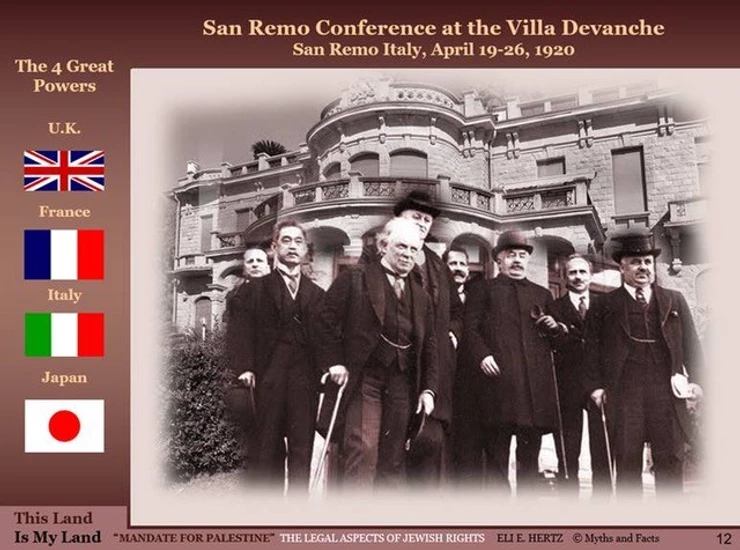
For Great Britain the priorities were Mesopotamia and Palestine. At San Remo they would be assigned those territories, not as colonizers — as had been decided at Paris — but as the mandatory power, on behalf of the League of Nations. Syria and Lebanon would be separate French mandates, so what would transpire there would have to be worked out between the Arab leaders and Paris, despite the frictions that existed between them. The mandatory powers would be charged with nurturing new nations into existence; one of them — Palestine — would be the Jewish homeland, but with the civil and religious rights of non-Jews protected.
Lloyd George, who, as prime minister, had authorized the Balfour Declaration, headed Britain's delegation at San Remo. The Earl of Balfour attended, but not in the role of foreign minister, having been replaced by Lord Curzon. It was Curzon who, at San Remo, pushed for inclusion of the Balfour Declaration in the terms of the Mandate for Palestine.
The previous August, Balfour had sent Curzon and his committee a memo that emphasized the importance of the Zionist mission and the need for a viable Jewish homeland, even if that displeased the Palestine's Arab population. That might have seemed unfair to the Arabs, but what was set aside for the Palestine Mandate at San Remo represented only about four percent of the close to three million square kilometres (one million square miles) of the Ottoman Middle East; the Arabs were to receive 96 percent.
And it was a fully fledged Jewish state that the British wanted, or at least the opportunity for the Zionists to build one in time through a policy of encouraging Jewish immigration during the mandatory period, as both Balfour and Lloyd George confirmed. The actions of subsequent British governments that limited the number of Jews allowed into Palestine, on one pretext or another, was in later years denounced by Lloyd George as contrary to what was intended when the mandate was created. Not only did stifling immigration undercut the ability of the Zionists to build a state, it also had the tragic effect of closing off, in the 1930s and '40s, what could have been a route for Europe's Jews to escape their terrible fate at the hands of the Nazis.
Other countries attending the San Remo conference had their own interests, but all supported, to one degree or another, the idea of a Jewish state. Clemenceau's successor, Alexandre Millerand, came to San Remo looking for a role as protector of Catholics in the Holy Land, but settled for a clause guaranteeing the status of minority groups.
The British pushed for a Jewish homeland whose boundaries would be taken from the Bible — "from Dan to Beersheba" — along the lines of what the Zionists had asked for in Paris — and which Feisal (and Clemenceau) had agreed to. At San Remo, however, the French insisted on obtaining the northernmost area of that territory for their mandates. The British ultimately conceded to the French on that point, which was not central to their interests, to the great disappointment of the Zionists. The Italians, for their part, came to San Remo looking for backing for the Vatican's plan to internationalize Palestine, but settled for representation on a Zionist commission.
U.S. President Woodrow Wilson, who was not present at San Remo, was a foe of empires and a champion of national self-determination, including the Zionist cause. At Paris, Wilson had suggested dispatching a fact-finding body to the Middle East; it ended up as an all-American affair, the King-Crane Commission.
The report that the commission produced was contrary to the consensus at San Remo. It called for a single mandate that would comprise Syria, Lebanon and Palestine; there would be a single mandatory power, ideally the U.S. (but not France); and the government would be headed by Emir Feisal. The Commission also recommended against large-scale Jewish immigration to Palestine and against the emergence of a Jewish state there.
The report, however, was not made public at the time, and even the attendees at San Remo may not have been aware of its contents. It was not until two years later, in 1922, that the recommendations of the Commission appeared, when they were published in an American magazine. That same year, the U.S. — which had chosen not to join the League of Nations — passed a joint Congressional resolution unanimously supporting a Jewish homeland in Palestine.
The San Remo Conference, where Great Britain's representatives expressed wholehearted advocacy for the idea of a Jewish state, marked the high point of that country's support for Zionism. Afterwards, both London's policies and the behaviour of the local authorities served to work against what the Jews were trying to achieve. That was so despite what had been decided at San Remo and in defiance of the League of Nations, in whose name the mandates were assigned.
Palestine, during the two years between the San Remo Conference and the Mandate's ratification by the League, was marked by Arab violence targetting Jews, with many dead and wounded on both sides. While the Arabs were the acknowledged aggressors, the British refused to treat them any more severely than their victims. Even more incriminating are reports that senior British officials actually encouraged Arab attacks on the Jews.
It was also during that period that Winston Churchill, Britain's Colonial Secretary, without discussing the matter with the Zionist leadership, proclaimed that all of Palestine that lay east of the Jordan River would be closed off from Jewish settlement. The future Prime Minister, who regarded himself as a supporter of Zionism, made the announcement on a visit to the Middle East.
While in Jerusalem he planted a tree at the site of the Hebrew University, where he predicted that "the building of a Jewish national home in Palestine will be a blessing to the whole world...to the Jewish race...to Great Britain."
Then, only weeks later, he announced the decision that would have the effect of reducing the size of that national home to one quarter of Mandatory Palestine.Three-quarters of the land would now be used to form an additional Arab state to be known as Transjordan. Churchill offered the throne of Transjordan — today called Jordan — to Feisal's brother Abdullah, who happened to be close by, on his way to attack the French.
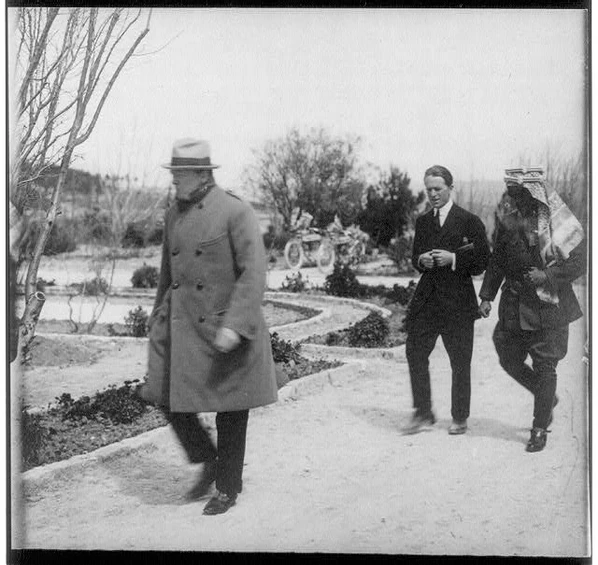
France had exiled Feisal from Syria and Abdullah's intention had been to restore Hashemite rule there, but he was pleased to accept the consolation prize of Transjordan for himself. Churchill's gesture, although a major blow to the Zionists, was a tremendous gift to the Arabs in general, and a reward to the Hashemites for their wartime assistance. A year later Britain made Feisal king of Iraq.
Britain's case for hiving off the new Arab state from Palestine was expressed in a document referred to as the "Churchill White Paper," which also contained other measures to backpedal on what the Zionists had been granted at San Remo: Immigration would be limited by "economic capacity" and would not lead a Jewish majority; the new Jewish Agency would not have "any share in the general administration of the country;" and Palestine would never become "as Jewish as England is English." And all this before the Mandate had officially begun!
The Zionists, despite their disappointment, felt that they had no choice but to accept the terms of the White Paper, since it still left them with the promise of a Jewish state in what remained of Palestine. And it was for that same reason — that there would be any kind of Jewish state — that the Arabs rejected it.
In July of 1922 the Council of the League of Nations unanimously approved the Mandate for Palestine, but with a retroactive recognition of the partition of the territory that Britain had carried out a year earlier. Mandatory Palestine — now bounded by the Mediterranean Sea to the west and the Jordan River to the east — was a much a smaller entity than it had been, and so would be the Jewish homeland it would become, but there would otherwise be no loss of any of the rights that had been granted at San Remo.
It should be pointed out that no special status was given under the Mandate to the part of the territory that the Jordanians named the West Bank after they occupied it (1948 to 1967), and which they no longer claim, or to the Gaza strip, which was occupied by Egypt during the same period. The lines on the map that demarcate those places were regarded by all countries not as borders but as armistice lines, indicating where the armies that invaded the newly established State of Israel were halted.
In 1945, the League of Nations Mandate for Palestine was incorporated in the Charter of the United Nations as Article 80, thus further reinforcing, as of its independence, Israel's sovereignty within the Mandate's borders. That sovereignty is also recognized in international law by the principle of uti possidetis juris, under which a newly formed state inherits the borders of the territory that it replaces.[4] That doctrine has been applied over many years when, for example, colonies were replaced by new, independent nations.
It was at San Remo, one hundred years ago, where the world recognized the right of the Jews to build — to rebuild — their national home. The Jews of Palestine would be able to develop a state within the framework of a new concept, a mandate, established by the international community and under its authority. One day the mandate would end and a new Jewish state would replace it.
As it turned out, the Jews had to sacrifice more than their labour to build their state; it was a constant struggle, in which many had to give their lives. Israel was forced to defend itself in battle from the moment statehood was declared in 1948. A generation later, in 1967, when the country was again attacked, it not only survived but emerged with all the territory it had inherited under the Mandate. And that is why, today, Israel cannot be accurately described as the illegal occupant of any of that territory.
Footnotes
[1] http://www.acpr.org.il/ENGLISH-NATIV/02-issue/grief-2.htm
[2] https://www.ownerdirect.com/vacation-rental-community/san-remo/castello-devachan
[3] https://www.americanthinker.com/articles/2010/04/israels_right_to_exist_as_a_je.html
[4] https://arizonalawreview.org/pdf/58-3/58arizlrev633.pdf
Julian Zuckerbrot is a Canadian writer and editor. He is a recipient of the Science Writers of Canada Award.
This article was posted by the Canadian Antisemitism
Education Foundation (CAEF)
and is archived at
https://www.caef.ca/post/israel-s-magna-carta-is-100-years-old
It is archived at Think-Israel at
http://www.think-israel.org/zuckerbrot.israelsmagnacarta.html